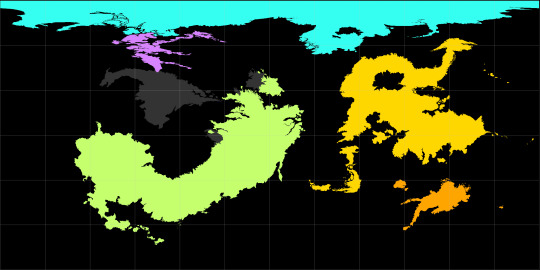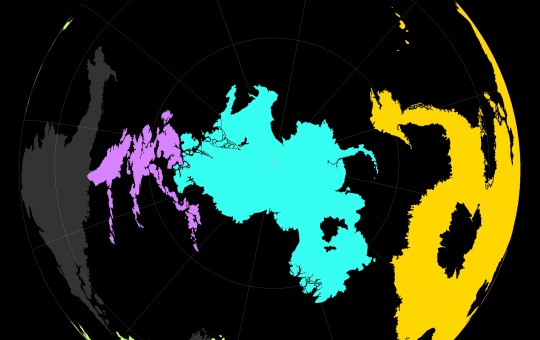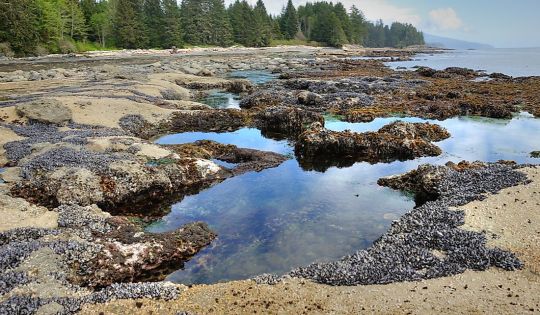#the guiding philosophy here is keep it in the neighborhood of earthlike but in a way that
Note
i am asking you about tdt! remnant with particular interest in unhinged climate




it is so kind of you all to enable me (@meltedintoair @froginboillingpastawater @lemon-embalmer @blakistan)

don’t mind the unfinished continent i’m still (through gritted teeth) figuring the strandlines out… also if you’re wondering why solitas looks like that it’s because for narrative reasons i needed land at the north pole here’s what she looks like Put Together

ANYWAY you will notice that i’ve moved things around. anima and menagerie north by a solid 30’ and rotated sanus a little bit counter-clockwise for the sake of not having vale and vacuo on almost the same latitude. mostly this is for the sake of bringing the various climates of these places into more reasonable bounds for an earthlike-ish climate—except for vale, which has a maritime climate with cool summers and coldish winters at 6’N, because i fixated on the puzzle of “earthlike climate except for this One Region” like you would not believe.
but before we get to Refrigerated Vale we have to talk about
✨the moons✨
yes moons plural. because i looked at the broken moon and heard the siren call of THE TIDES. tdt!remnant has three moons: mar, the original, which is (like the canon moon) not tidally locked and has a massive dark crater on one side (THE MOUTH OF THE MOON–), and the much smaller anthe + ogmios, which formed through the accretion of debris flung away when the god of darkness exploded the moon and are smaller.
INCIDENTALLY the hegemonic calendar is a lunisolar calendar with months correlating to mar’s cycle and 8-day weeks (octs) correlating to ogmios’ much shorter cycle; anthe is culturally associated with the god of animals and khimerism—that’s the monotheistic worship of the god of animals practiced by many fauni—has an anthean lunar calendar that is wildly different. the vytali common calendar has 12 months divided into 8-day octs (with some gnarly intercalation going on to align the calendar with the solar year); the khimeric calendar has 17 months divided into 9-day enneads with an intercalary month and handful of three-day-long leaping festivals that rotate the calendar through the solar year in a fifteen year cycle. it would be remiss of me not to plug fantasy-calendar for all your batshit calendar making needs. i have a spreadsheet where i pin down all the math and then just set everything up in FC it has never let me down.
back of napkin math:
on average the tides are about +/- 3.9 m. neap tides where all three moons pull against each other, +/- 3.7 m. spring tides where they line up, +/- 4.2—these are the open ocean tidal range, coastal tides are highly variable but as a very rough estimate tidal ranges along the (habitable) coasts are probably somewhere between ~2 and ~16m, with significant amounts of uninhabitable coastline where the tidal range is much larger and building on the high tide coast means your settlement is several kilometers inland at low tide. riverside building is also quite difficult because tidal bores are. pretty extreme
port cities don’t have harbors the way we think of them. they have either sprawling, complicated systems of locks operated by konurgists (=professional practitioners of dust-based magic) or they have cliffside dry docks designed for lightweight vessels to ride in and out with the tides. vale’s wharf district is a maze of locks and caissons. argus and kuo kuana have dry harbors.
the other thing about multi-moon systems is you get more significant tidal flexing ergo more volcanism
so where earth experiences ~70 volcanic eruptions per year on average, remnant the triple moon tsunami tides planet gets to have a “statistically there is always a volcano erupting somewhere in the world” trivia question, and all the air quality problems and acid rain you get from that.
SO the first consideration with regard to tdt remnant’s earthlike climate is that the conditions which produce it are very different; i… am That kind of person who back of napkin crunched numbers for all of this (and spent like an hour fiddling to not tidally lock the planet to the star 😭) BUT the numbers don’t matter per se; the salient piece is that the sun is both cooler and a little further away than ours (<- yes this IS me looking into the camera like i’m on the office about the god of light) and the planet is kept habitable by tidal heating, meaning the friction produced by the moons stretching and squeezing the planet as they orbit around it.
the moons stress balling the planet is also what causes The Volcanoes, which release greenhouse gasses (keeping remnant warmer than it would otherwise be) but also semi-regularly you’ll get enough big eruptions in clusters to Deflect The Fucking Sun like it’s 1816 and global temperatures nosedive and climates all over go haywire for a year or two. i think this happens on average about once per century but the current historical period—the seventh era—begins with a quarter century called the forge years when the planet got HAMMERED by four really bad volcanic winters in quick succession. think “14th century black plague” levels of decimation, except it was worldwide famines + just an explosion of conflicts and wars over food sources + grimm, whose populations spike whenever there’s a major volcanic event because the planet’s mantle is a mixture of molten rock and atrum (=grimm juice).
(there are very few true herbivores in this world. there are a lot of animals that eat plants when it’s warm and meat when it’s cold. true herbivores tend to be either animals that store huge food caches or animals that can go a really, really long time without eating. plants mostly either develop super deep root systems, or pump out antifreeze proteins when the temperature drops, or develop cold-mediated serotiny, or a combination.)
BECAUSE OF ALL THAT, remnant’s oceans circulate in a completely different way than ours; tidal heating warms the bottom water at the poles, causing it to rise in strong east-to-west or west-to-east currents, forcing colder surface water downwards and flowing towards the equator. consequently remnant does not have permanent ice caps, although most of solitas is perpetually snowy above its strandline.
(the strandline is where the water is at high tide; as noted in many cases this is several kilometers inland from the low-tide coast. anima, solitas, alukah—that’s the unnamed dragon continent—and sanus are all a single contiguous landmass at low tide, with huge land bridges exposed. it is generally not a good idea to try to walk, with the exception of one specific island chain that is small enough to traverse safely on foot by walking island-to-island over a span of about three days, four if you’re being cautious.)
the upshot of all this is it’s relatively warmer and wetter at the poles and cooler and drier at the equator compared to earth, because the oceans are effectively upside-down, warmest at the bottom near the poles. (if you’re wondering why the tidal heating is distributed this way, the real-world exemplar i’m working from is europa. interesting reading!)
northern anima is a bit of a special case because even though it looks coastal, it isn’t; the sea in between it and solitas is very, very shallow and at low tides is just this for hundreds of kilometers:

so within that curve of the “dragon neck” shape, the whole strandline is functionally landlocked with respect to the warm rising polar currents and during the wintertime can actually get colder than the region of solitas where mantle is located.
and then there’s the impact of dust.
i’ve drifted quite a bit off the basic ‘fantasy elements’ approach taken with dust in canon because the concept of dust as a sort of crystallized energy appeals to me; so there are four basic kinds of dust (thermal, electromagnetic, kinetic, chemical) which can be further divided into subcategories by their specific actions. for example most ‘burn’ and ‘ice’ dusts belong to the thermal family and are distinguished by whether they radiate heat or absorb it. and i say ‘most’ because there are also things like organic-solar/“bog” dust, which forms in peat deposits and produces heat but is classed as an electromagnetic dusts because it’s solar-powered.
large deposits of dust modify the regional climate in often dramatic ways. and this is how we get Refrigerated Vale—the difference between vale and other equatorial regions isn’t as huge as it would be on earth, because remnant’s equatorial band is relatively cool and generally falls more into a ‘warm-to-hot mediterranean climate’ than tropical, but vale is very noticeably cold for its latitude. there are Two Reasons for this.
one is what i’m calling the tarthic koniohaline climate system (TKCS pronounced “ticks”). the tarth sea—that’s the body of water surrounded by alukah, solitas, and sanus—has a huge, several-hundred-kilometer-long seam of variegated dust running along the southern continental shelf, roughly following the curve of the alukite/sanite coastline but further out to sea. (“variegated” meaning it’s a mixture of different types all sort of entangled together.) sort of akin to a barrier reef, but dust.
the tarthic dust formation is mostly a mix of absorptive thermal dusts (colloquially: frost) and kinetic dusts (colloquially: tidal) which together act to cool and desalinate water upwelling against the continental shelf, which is then pushed southward in a clockwise direction along the sanite/alukite coast. that produces a very cool, wet climate along the coastline with frequent thunderstorms as cold fronts coming off the water collide with warmer air rising from the vivax sea to the south (which again: think mediterranean).
vale sits on the southern periphery of the TKCS and is cooled by prevailing winds originating from the tarthic coast. it isn’t as rainy year-round as the vitrine peninsula but it does get quite a lot of precipitation.
the other factor Refrigerating Vale is that there’s absorptive thermal dust in the mountains, too. eastern vale—the counties in the northeast part of the continent, which were contested during the great war and (unlike in canon) not wholly lost to the grimm—has a very pleasant climate, warm summers and mild rainy winters, sometimes snow in the north and at higher altitudes. prevailing winds are fairly dry and warm when they hit the mountains and then rake over peaks that are just covered in frost/ice dusts and act as a giant heat sink, so western vale gets these bitterly cold, super dry winds pouring down the mountains during the summer that collide with warm coastal winds and cause huge storms. in winter the prevailing winds are much weaker, though still freezing, and blow further out to sea so there are fewer storms and infrequent snow but the snow that does fall tends to stick until the spring.
and that’s why the maragda valley is nicknamed the world’s refrigerator and vale’s chief export is various frost/ice dusts :)
OTHER FUN DUST-RELATED THINGS.
the southern part of alukah is called the mordicchiate coast and it’s one of the only regions in the world with a true tropical climate because it’s very, very rich in an assortment of kinetic dusts (mostly different grades of grav) that essentially cook the region by Vibrating Constantly
the other tropical region is in equatorial anima, a big swath of jungle and humid-subtropical grassland in what’s called the palash basin. it’s hot because it’s the caldera of an ancient supervolcano and one of the most volcanically active regions in the world. there are a lot of grimm. there are so many grimm in the palash basin. there’s also a strip of super-fertile land running along the northern rim of the palash region so people keep trying to live there anyway.
along the southwestern coasts of solitas (where those free villages are in arrowfell) there are just enormous underground seams of radiant thermal dusts which heat up the land enough that it’s possible to farm there during the summers; it still snows year-round, but the soil isn’t frozen so all you need is tents with clear panels you can uncover/cover to control sunlight.
the nequam desert—that’s the one surrounding vacuo—is also laced with radiant thermal dusts that bake what would otherwise be a warm arid steppe into a parched, burning-hot desert that wants to kill you. there are hotspots all over the place where the dust veins are so close to the surface that you can cook on the ground; nomadic desert peoples notoriously almost never use cooking fires and were instrumental to vacuo’s success in the great war because radar systems were still very rudimentary and no fires at night meant vacuan guerrillas could maneuver undetected until they appeared seemingly out of fucking nowhere to maul enemy supply convoys.
the wildlife in the menagerian interior are unique on remnant because there is a preponderance of electromagnetic and chemical dust formations on the surface—mostly “shock” dusts, which discharge or generate electricity—and the animals living have been in an evolutionary arms race for millions of years with the result that if it can’t generate electrical shocks on its own, it’s gluing electric rocks to itself decorator-crab style or it’s got specialized structures in its mouth that it can pack dust into and discharge shocks from when it bites you. “how can the wildlife be more dangerous than the grimm,” the rest of the world asks. “we have scorpions whose stings deliver an electric shock at a high enough voltage to kill you before you hit the ground,” says menagerie. “and lightning snakes. and an electrical tortoise. and storm bears–”
there’s a volcano called mount halog on the northwestern dragon-head peninsula of alukah that began to erupt in 332 VE—twenty-five years ago—and has been more or less continuously oozing lava and half-formed grimm ever since.
acid rain (and snow) is a worldwide issue because of the extreme volcanism and in rainy climates settlements exist in a more or less constant state of repair and reconstruction; once a settlement is abandoned it will fall into ruin very, very fast unless the climate is extremely arid. the most volcanically active regions in the world are northern alukah, the palash basin, and the east coast of anima; volcanic smog blows north to kuchinashi from the palash basin fairly regularly.
black rain is a very dangerous weather phenomenon caused by ateric ash—the stuff grimm disintegrate into when they die—floating up into the atmosphere and then precipitating down as liquid atrum. which. coagulates into new grimm. the drippings from the wyvern in canon are the same in principle but much more severe; typically black rains will spawn lots of small grimm—think rat- or cat-sized—and may not leave puddles large enough to form something like a beowolf at all. but a swarm of rat-sized grimm is still no picnic, and black rain is difficult to forecast, so within the vytal league it’s standard practice for huntsmen and grimm extirpation forces to be kept at the ready whenever heavy precipitation is expected, just in case it’s tainted.
the oceans are also quite a bit more acidic than earth’s and tend to be very nutrient-rich near the poles and barren with pockets of life here and there in the equatorial regions—which, as discussed in the Whale Post, in combination with the relative cold creates selective pressure for VERY LARGE akin to the phenomenon of abyssal gigantism but extended higher into the middle pelagic zones. the greatest diversity and density of oceanic life is around the north pole.
(the MONSTER WHALES are called hafgufa, females live in pods around the north pole, males are solitary and range worldwide.)
also,
because atrum does not freeze above absolute zero, and because the planetary mantle is atrum intermixed with magma, every spreading rift in the ocean also constantly pumps out rivers of atrum, which 1. plays an important role in moving and mixing waters to sustain those pockets of nutrient-rich waters where marine life flourishes in the equatorial regions, and 2. slowly but steadily spawns diluvian grimm. the VAST majority of grimm in the world are sea monsters born from these underwater rivers :)
#the guiding philosophy here is keep it in the neighborhood of earthlike but in a way that#only emerges through the interaction of these hellish extremes.#the brothers’ world was a paradise by divine fiat—without them remnant needs constant volcanism to be habitable.#through destruction: life.#the plate tectonics subordinate to the themes or else what’s the point. etc.
36 notes
·
View notes